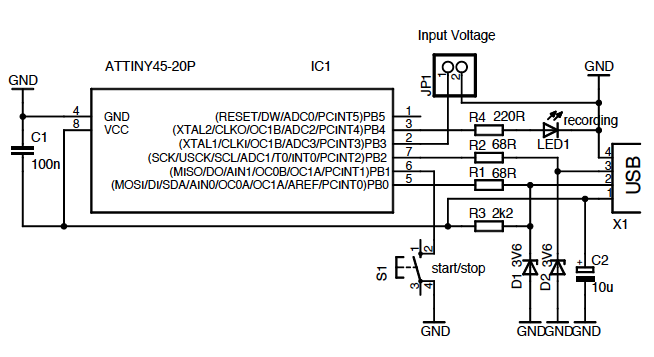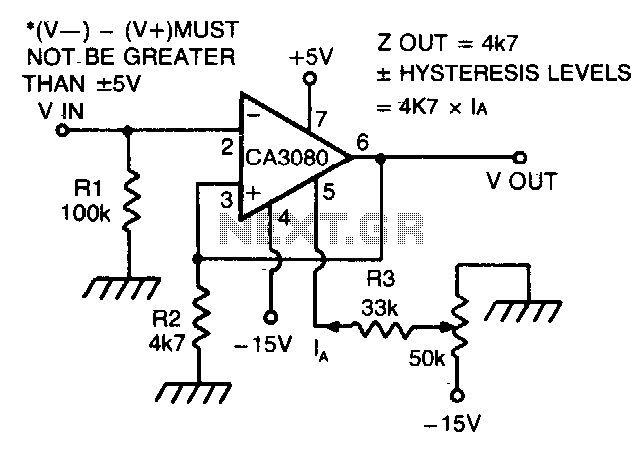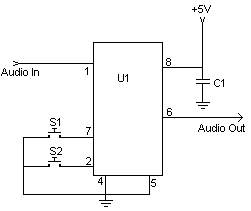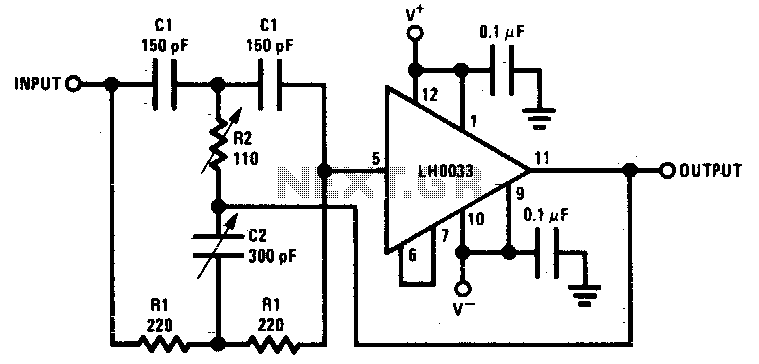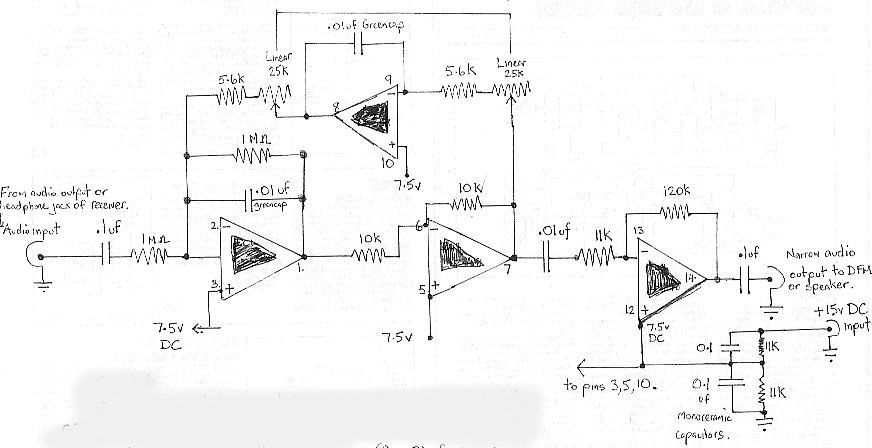
By setting the cutoff frequency of the programmable digital low-pass filter
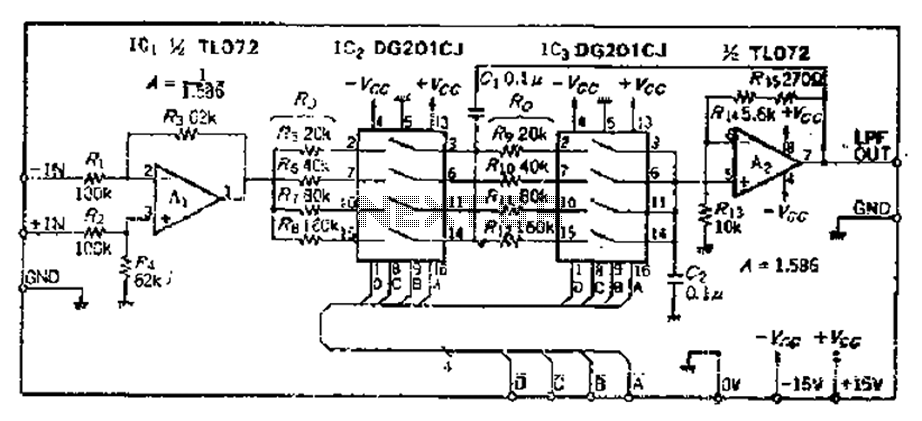
The circuit primarily consists of two Butterworth filters, designed to create a feedback amplifier with a gain of approximately 0.707. It features a differential input amplifier, where one input is grounded, resulting in a single input terminal. The attenuation filter gain is set to approximately 1.586 to ensure a passband gain of 0 dB. The feedback resistor, Rs, is specified as 63.92 kΩ (with a nominal value of 100 kΩ leading to 1.568), and the closest series resistance available is 62 kΩ. The frequency-setting resistor is configured using a readily available 0.1 µF capacitor, calculated for the lowest cutoff frequency, which is set at 10 Hz. For this frequency, the output impedance is approximately 159.2 kΩ. At 20 Hz, the output impedance becomes 79.6 kΩ, and at 40 Hz, it is 39.8 kΩ. The gain decreases by half for every doubling of frequency, with the lowest frequency of interest being set at 30 Hz, resulting in an output impedance of approximately 53.33 kΩ. By adjusting the component values, the cut-off frequency can be varied within the range of 0 to 80 Hz. To minimize errors caused by the on-resistance of the analog switch, a high feedback resistance of at least 20 kΩ is utilized. Assuming a resistance value of 500 Ω, the cutoff frequency remains within 0.25% of the calculated value, which is deemed acceptable. For each frequency band starting from 10 Hz, component values should be adjusted accordingly.
The circuit described is a sophisticated implementation of a dual Butterworth filter configuration, optimized for a feedback amplifier application. The design leverages the Butterworth filter's characteristic of providing a maximally flat frequency response in the passband, making it suitable for applications requiring high fidelity and minimal distortion.
The differential input amplifier design, with one input grounded, ensures that the circuit operates effectively as a single-ended amplifier. This configuration is particularly useful in scenarios where noise rejection is critical, as it allows for the cancellation of common-mode signals.
The feedback resistor, Rs, plays a crucial role in determining the gain of the amplifier. The selection of 63.92 kΩ provides a balance between the desired gain and the stability of the amplifier. The choice of standard resistor values, such as 62 kΩ, simplifies the procurement and assembly process while maintaining performance integrity.
The use of a 0.1 µF capacitor for setting the cutoff frequency is a practical approach, as it allows for easy adjustments to be made in response to varying application requirements. The calculated output impedance values at different frequencies indicate the amplifier's performance characteristics across the intended frequency range. The noted decrease in output impedance with increasing frequency is a typical behavior of passive filter designs, which must be accounted for in system integration.
The design's flexibility in adjusting the cutoff frequency from 0 to 80 Hz enhances its applicability across various audio processing tasks, making it suitable for equalization and other signal processing applications. The implementation of high feedback resistance mitigates the impact of switch resistance, ensuring that the performance remains within acceptable limits, thus enhancing the overall reliability of the circuit.
In summary, this dual Butterworth filter feedback amplifier circuit is a well-engineered solution for high-fidelity applications, combining effective noise rejection, adjustable frequency response, and robust performance characteristics. Proper component selection and configuration are key to achieving the desired operational parameters while ensuring minimal distortion and optimal signal integrity.As can be seen from the circuit loop, the circuit is mainly two times a Butterworth filter, in order to make a 0.707, magnification feedback amplifier d was d 3- (1/Q) 1. 5860 input amplifier a differential input type, but also to one input is grounded, with only one input terminal, and wherein attenuation filter gain should amount (I.58 6-fold) are equal, in order to ensure that the passband gain of OdB. Feedback resistor Rs is 63k92 (Rs I00 kO 1. 568 63kQ), take the closest series resistance is 62 kC20 on the frequency setting resistor set -: mouth i.Ca using readily available 0,1 F capacitor, according to the lowest frequency (ie, the cutoff frequency of each file) calculation chu.
When, 10Hz, the ugly. 1 only stone 0 * 1 l0-ox 10 159. 2kQ}, 20Hz time, Ro 159,2kC) xl/2 79.6k O, 40 Hz, the clamor. 39, 8kQ, increments every two times, said o reduces 1/2 0 if the lowest frequency, whichever is 30Hz, and ugly as the work level, alum was 53. 33kQo by setting L ~ 1 of 5 data, you can make the change in the cut-off frequency fc] O ~ isOHz range.
Due to a series of on-resistance analog switch, in order to minimize errors, R. With a high resistance, minimum resistance to 20kQ, assuming that r. - 500, cut-off frequency lower than the calculated value of 0.25%, the election is practically permissible. The circuit of each file by frequency IOHz, if each file up-iOOH ztCL.g Wang capacity should be changed to 0.
OILiFo
The circuit described is a sophisticated implementation of a dual Butterworth filter configuration, optimized for a feedback amplifier application. The design leverages the Butterworth filter's characteristic of providing a maximally flat frequency response in the passband, making it suitable for applications requiring high fidelity and minimal distortion.
The differential input amplifier design, with one input grounded, ensures that the circuit operates effectively as a single-ended amplifier. This configuration is particularly useful in scenarios where noise rejection is critical, as it allows for the cancellation of common-mode signals.
The feedback resistor, Rs, plays a crucial role in determining the gain of the amplifier. The selection of 63.92 kΩ provides a balance between the desired gain and the stability of the amplifier. The choice of standard resistor values, such as 62 kΩ, simplifies the procurement and assembly process while maintaining performance integrity.
The use of a 0.1 µF capacitor for setting the cutoff frequency is a practical approach, as it allows for easy adjustments to be made in response to varying application requirements. The calculated output impedance values at different frequencies indicate the amplifier's performance characteristics across the intended frequency range. The noted decrease in output impedance with increasing frequency is a typical behavior of passive filter designs, which must be accounted for in system integration.
The design's flexibility in adjusting the cutoff frequency from 0 to 80 Hz enhances its applicability across various audio processing tasks, making it suitable for equalization and other signal processing applications. The implementation of high feedback resistance mitigates the impact of switch resistance, ensuring that the performance remains within acceptable limits, thus enhancing the overall reliability of the circuit.
In summary, this dual Butterworth filter feedback amplifier circuit is a well-engineered solution for high-fidelity applications, combining effective noise rejection, adjustable frequency response, and robust performance characteristics. Proper component selection and configuration are key to achieving the desired operational parameters while ensuring minimal distortion and optimal signal integrity.As can be seen from the circuit loop, the circuit is mainly two times a Butterworth filter, in order to make a 0.707, magnification feedback amplifier d was d 3- (1/Q) 1. 5860 input amplifier a differential input type, but also to one input is grounded, with only one input terminal, and wherein attenuation filter gain should amount (I.58 6-fold) are equal, in order to ensure that the passband gain of OdB. Feedback resistor Rs is 63k92 (Rs I00 kO 1. 568 63kQ), take the closest series resistance is 62 kC20 on the frequency setting resistor set -: mouth i.Ca using readily available 0,1 F capacitor, according to the lowest frequency (ie, the cutoff frequency of each file) calculation chu.
When, 10Hz, the ugly. 1 only stone 0 * 1 l0-ox 10 159. 2kQ}, 20Hz time, Ro 159,2kC) xl/2 79.6k O, 40 Hz, the clamor. 39, 8kQ, increments every two times, said o reduces 1/2 0 if the lowest frequency, whichever is 30Hz, and ugly as the work level, alum was 53. 33kQo by setting L ~ 1 of 5 data, you can make the change in the cut-off frequency fc] O ~ isOHz range.
Due to a series of on-resistance analog switch, in order to minimize errors, R. With a high resistance, minimum resistance to 20kQ, assuming that r. - 500, cut-off frequency lower than the calculated value of 0.25%, the election is practically permissible. The circuit of each file by frequency IOHz, if each file up-iOOH ztCL.g Wang capacity should be changed to 0.
OILiFo
